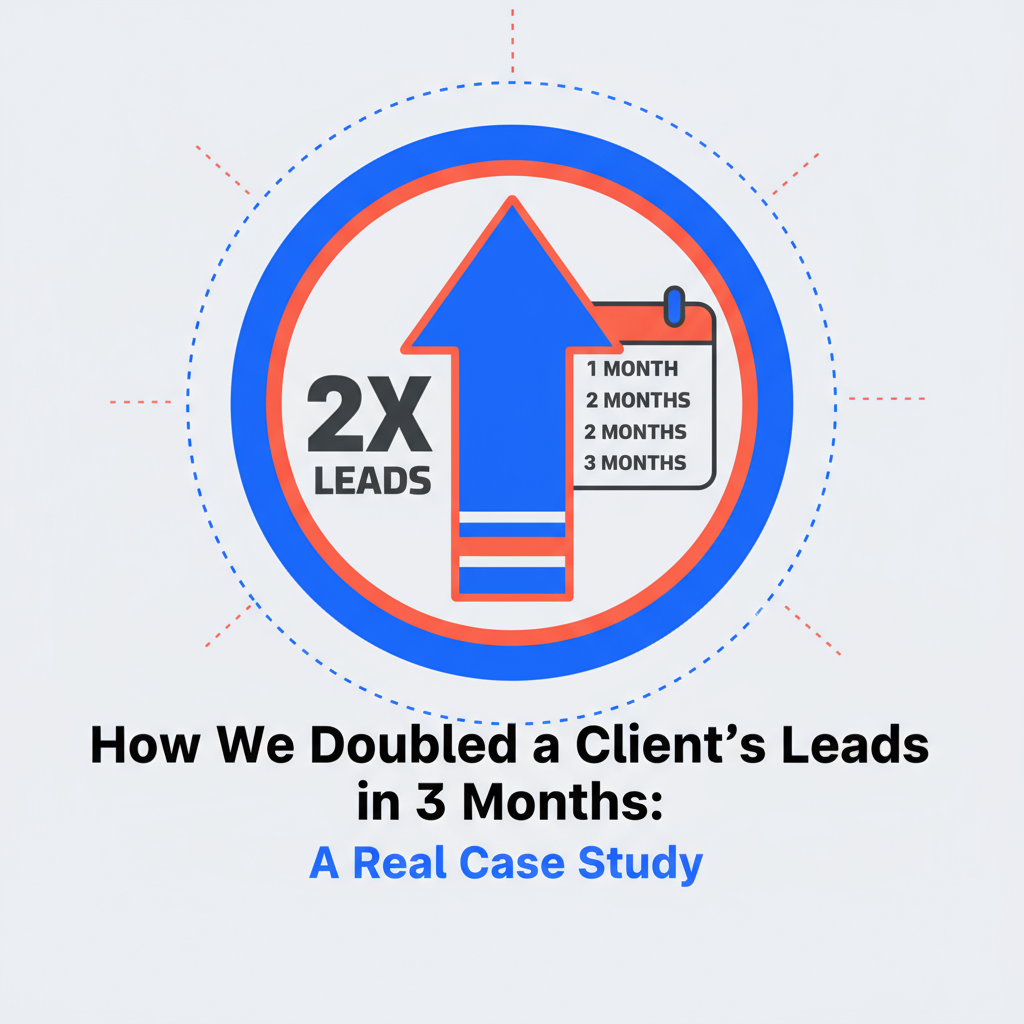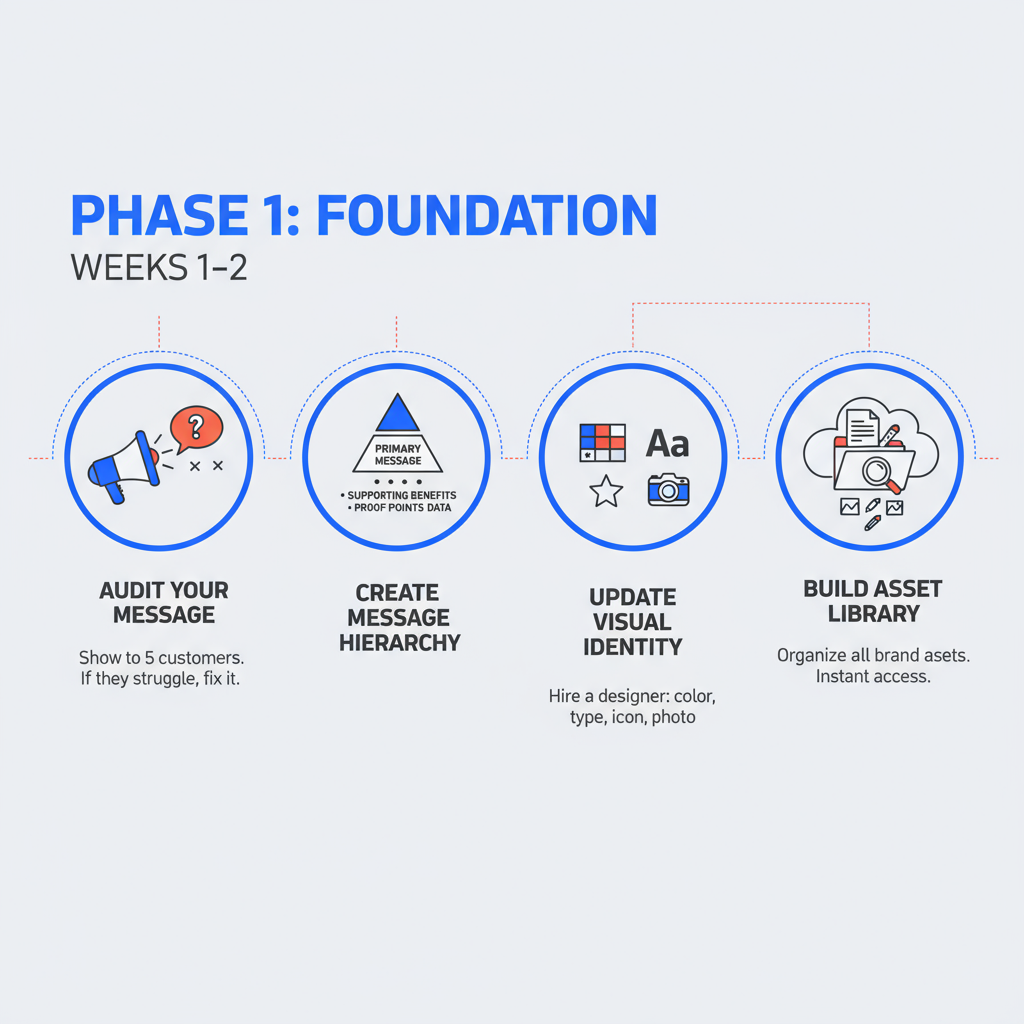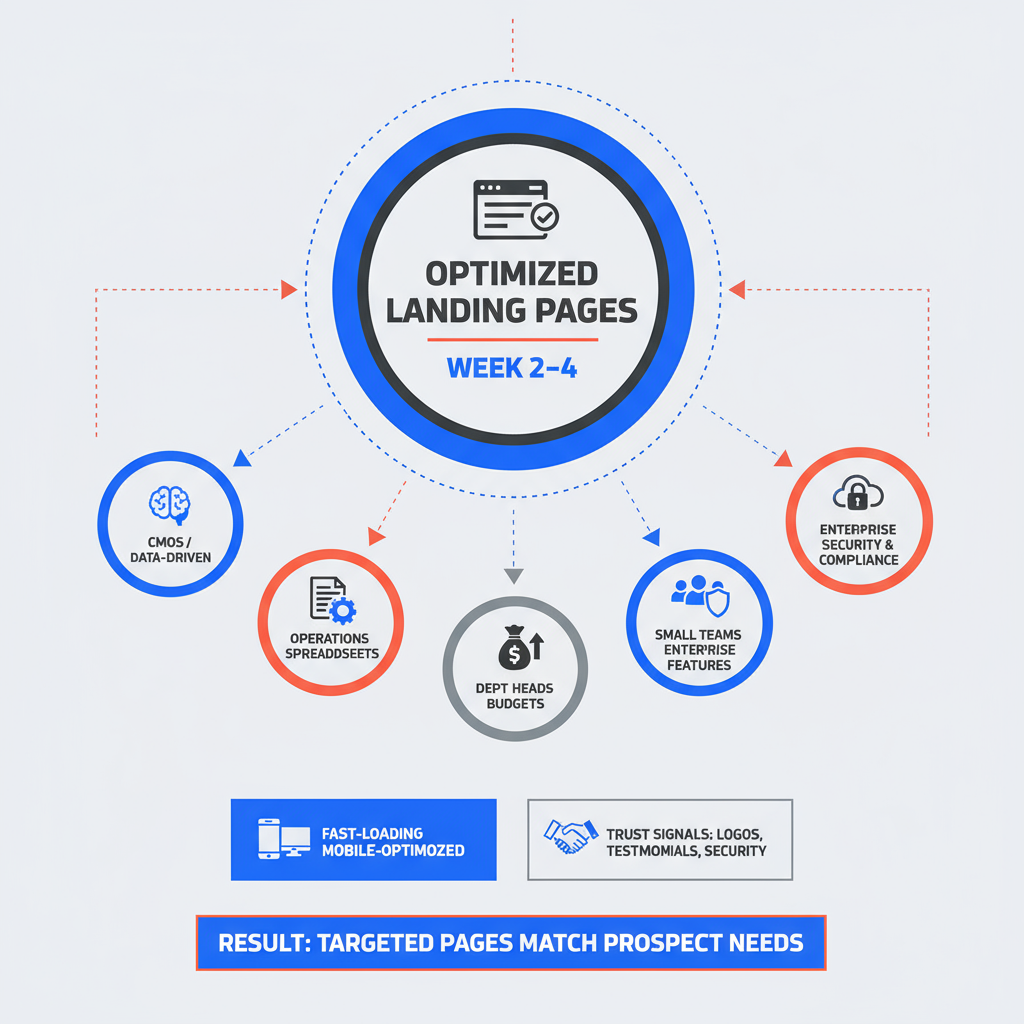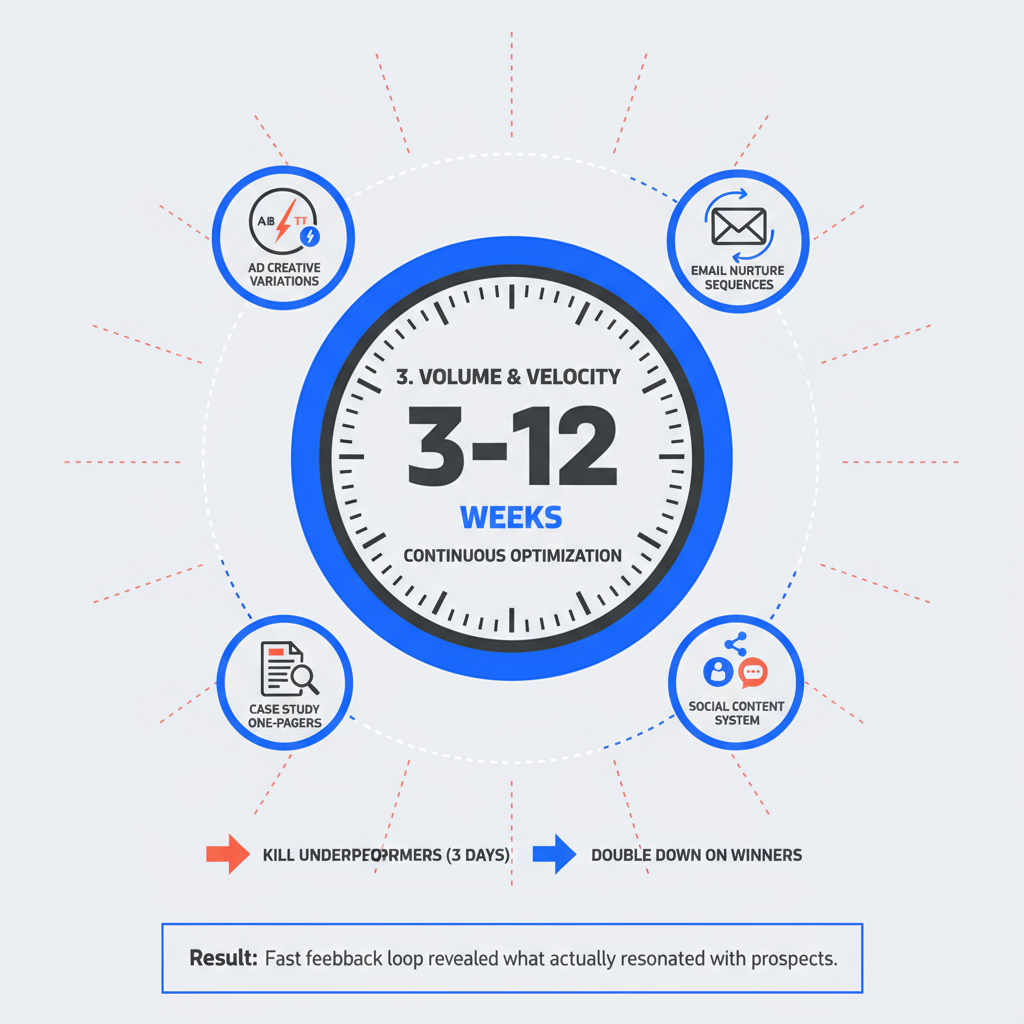

Company: CloudMetrics (B2B SaaS analytics platform)
Timeline: March–May 2024
Result: 127% increase in qualified leads, 68% reduction in cost-per-lead
When CloudMetrics reached out to Adaptif in February 2024, they were stuck. Their product was solid, their market was growing, but their lead generation had plateaued. Despite spending $18,000 monthly on ads and agencies, they were generating only 40–50 qualified leads per month—barely enough to hit their growth targets.
Three months later, they were closing 110+ leads monthly, their sales team was overwhelmed (in a good way), and their marketing director had finally stopped waking up at 3am worrying about pipeline.
This is the complete story of how we did it—including what worked, what didn't, and the exact strategies any B2B company can replicate.
[[center]]CloudMetrics had raised a solid Series A and was ready to scale. Their analytics platform helped mid-market companies make sense of their data without hiring data scientists. The product delivered clear ROI, retention was strong, and existing customers were happy.
But marketing was a mess.
Creative bottleneck:
Their agency took 2–3 weeks to produce landing pages. By the time assets launched, campaign timelines were blown and opportunities missed.
Inconsistent messaging: With different freelancers handling different projects, their brand voice changed from asset to asset. Prospects couldn't get a clear picture of what CloudMetrics actually did.
No testing capacity:
Every design cost $1,500–$3,000, so they launched one version of everything and hoped it worked. When it didn't, they had no budget left to iterate.
Fragmented workflow:
Marketing manager Emma spent 15+ hours weekly coordinating between the ad agency, web designer, copywriter, and developer. "I was a project manager, not a marketer," she told us later.
The breaking point:
They planned a major product launch for April with a $25,000 budget. Two weeks before launch, their agency delivered creative that completely missed the mark. With no time to pivot and no budget for revisions, they delayed the entire launch—costing them an estimated $80,000 in lost revenue.
That's when Emma's CEO gave her a mandate: fix the creative workflow or we're hiring a CMO to replace you.
[[center]] When Emma contacted Adaptif, she thought she needed faster designers. After our discovery call, we realized the problem was deeper.
Landing page graveyard:
CloudMetrics had six different landing pages, none optimized. They were driving all traffic to their homepage, which had a 1.2% conversion rate.
Value proposition confusion:
Their messaging focused on features ("advanced data visualization") instead of outcomes ("make decisions 10x faster").
Creative debt:
Their brand guidelines were two years old. Visual identity had drifted as different designers interpreted things differently. Nothing looked cohesive.
No feedback loop:
They ran ads, tracked conversions, but never connected creative performance to lead quality. They didn't know which messages or visuals actually resonated.
Underutilized channels:
All budget went to LinkedIn ads. No email nurture, no organic content, no retargeting—just cold LinkedIn traffic to a mediocre homepage.
The real issue wasn't production speed. It was strategic creative execution.
We proposed a three-month sprint focused on three pillars:
Week 1–2: Complete brand refresh
Week 2–4: Landing page system
Result: Instead of one mediocre homepage, targeted pages matched to prospect needs
Week 3–12: Continuous optimization
Result: Fast feedback loop revealed what actually resonated with prospects



[[center]]The first month was foundational work—not immediately visible, but critical.
Brand assets:
Landing pages (5 total):
Initial ad creative (12 variations):
Email sequences:
Not dramatic yet, but the infrastructure was in place. More importantly, we learned which messages resonated.
Key insight:
Prospects cared most about "making decisions faster" (outcome) not "better data visualization" (feature). This became our core message going forward.
[[center]]With infrastructure built, we moved fast.
Every Monday:
Review previous week's performance data
Monday–Tuesday:
Design new creative variations based on insights
Wednesday:
Launch new tests
Friday:
Kill bottom 30% of performers, increase budget on top 30%
We ran this cycle every single week.
Ad creative variables:
Landing page elements:
Audience targeting:
Week 5:
We discovered that ads featuring a specific customer quote ("CloudMetrics cut our reporting time from 3 days to 20 minutes") outperformed generic value props by 340%. We immediately created 6 variations of this concept.
Week 6:
Landing pages with video explainers (showing the product in action for 90 seconds) converted 82% better than pages without video. We added videos to all landing pages.
Week 7:
The "Operations Leader" landing page converted at 4.7%—nearly double any other page. We shifted 40% of ad budget to target this segment specifically.
The momentum was building. Emma's CEO stopped asking about replacing her.
[[center]]By May, we knew what worked. Time to scale it.
We stopped testing radically new concepts and instead created more variations of proven winners:
Customer testimonial ads:
Created 12 different versions featuring different customers, industries, and specific results
Operations leader targeting:
Built complete campaign around this high-converting segment
Video content:
Produced 6 short product demo videos highlighting different use cases
Retargeting campaigns:
Created custom creative for people who visited but didn't convert
Email sequences:
Added product education content to nurture campaigns
Here's what happened when we combined multiple optimizations:
Old funnel (February):
New funnel (May):
Same budget, 6.5x more leads per 10,000 impressions.
The less visible wins mattered too:
Sales team impact:
Sales reps started closing deals faster because prospects arrived better educated (thanks to improved landing pages and email nurtures).
Brand perception:
Prospects commented on how "professional" and "clear" CloudMetrics felt compared to competitors.
Internal confidence:
The marketing team stopped second-guessing every decision because they had data showing what worked.
Resource allocation:
Emma went from 15 hours/week managing vendors to 3 hours/week reviewing Adaptif's work and providing strategic direction.
February (Before Adaptif):
May (Month 3 with Adaptif):
Overall Improvements:
Looking back, five factors drove these results:
Traditional timeline: 2–3 weeks per asset
Adaptif timeline: 24–48 hours per asset
When you can test something new every 2 days instead of every 3 weeks, you learn 10x faster. We ran 40+ tests in three months. With their old agency, they might have run 4.
Every touchpoint—ads, landing pages, emails, sales materials—reinforced the same message and visual identity. Prospects saw CloudMetrics everywhere and it all felt cohesive. Trust builds faster when your brand isn't a chaotic mess.
We matched each project to the right specialist:
Each expert understood the nuances of their channel. Generic designers can't deliver this.
Because Adaptif's model is unlimited requests, Emma never hesitated to ask for variations, iterations, or new tests. Traditional agencies would have charged extra for every revision, so clients limit testing to save money—which kills learning.
We didn't just execute requests. We analyzed performance data, suggested new tests, identified patterns, and pushed back when something wouldn't work. CloudMetrics got strategic thinking plus execution.
Not everything succeeded. Here's what flopped:
Founder-led content:
We created ads featuring CloudMetrics' CEO. They performed terribly (0.6% CTR). Prospects wanted to see the product, not the founder.
Generic stock photography:
Early landing pages used stock photos of "diverse teams collaborating." Conversion rates were 40% lower than pages using actual product screenshots.
Complex messaging:
We tested a headline that accurately described the technical capabilities: "Multi-dimensional data aggregation with real-time visualization." Nobody clicked. When we changed it to "Turn your data into decisions in minutes," CTR tripled.
Long-form ads:
We experimented with 500-word storytelling ads. Engagement was high but conversion was terrible. People read, enjoyed, but didn't convert.
Cute creativity over clarity:
One week we designed visually striking ads with abstract geometric shapes. They looked beautiful, won Emma's team's approval, but underperformed straightforward product-focused ads by 60%.
The lesson: B2B buyers want clarity and proof, not entertainment.
You don't need Adaptif to apply these strategies. Here's the tactical breakdown:
Total monthly tool cost: ~$800
When we share this case study, we hear these concerns:
"Our market is different, this won't work for us"
CloudMetrics' market wasn't unique. The principles—clear messaging, targeted landing pages, rapid testing—work in any B2B context. We've replicated similar results for fintech, HR software, and logistics platforms.
"We don't have budget for unlimited design"
CloudMetrics spent $18,000/month total. Their previous setup was $6,000 to agencies + $3,000 to freelancers + internal overhead. Adaptif cost $2,995/month, actually reducing their total creative spend.
"Our team doesn't have time to manage this"
Emma spent less time with Adaptif (3 hours/week) than with her previous agencies (15 hours/week). Consolidated vendor relationships reduce overhead, not increase it.
"We tried testing before and it didn't work"
Most companies test too slowly. They run one test per month, get inconclusive results, give up. CloudMetrics ran 40+ tests in 90 days. Volume matters.
"Our product is too complex for simple landing pages"
CloudMetrics' analytics platform was technically sophisticated. But prospects didn't need to understand the technical architecture—they needed to understand the outcome. Simplicity wins.
We stayed with CloudMetrics after the initial sprint. Here's where they are today:
Emma's title changed from Marketing Manager to VP of Marketing.
[[center]]Most companies treat design as a commodity—something to procure cheaply and occasionally. CloudMetrics' breakthrough came when they treated creative as a strategic growth lever.
The math is simple:
CloudMetrics didn't succeed because they spent more money. They succeeded because they moved faster, tested smarter, and maintained consistency.
The question isn't "Can we afford unlimited design?" It's "Can we afford to keep working the old way?"
If you're facing similar challenges—stalled lead generation, slow creative workflows, inconsistent results—here's what to do:
Step 1:
Calculate your current situation
Step 2:
Identify your bottlenecks
Step 3:
Consider your options
Step 4:
Run a sprintWhether with Adaptif or another solution, commit to 90 days of intensive testing and optimization. Measure everything. Learn fast.
The companies winning in 2025 aren't the ones with the biggest budgets—they're the ones that learn fastest.
Want to explore if we can deliver similar results for your business?
We offer free growth audits where we analyze your current creative workflow, identify bottlenecks, and show you exactly what a partnership with Adaptif would deliver.
No pressure, no obligation—just a clear picture of your potential.
[Book Your Growth Audit] [View Case Studies]

